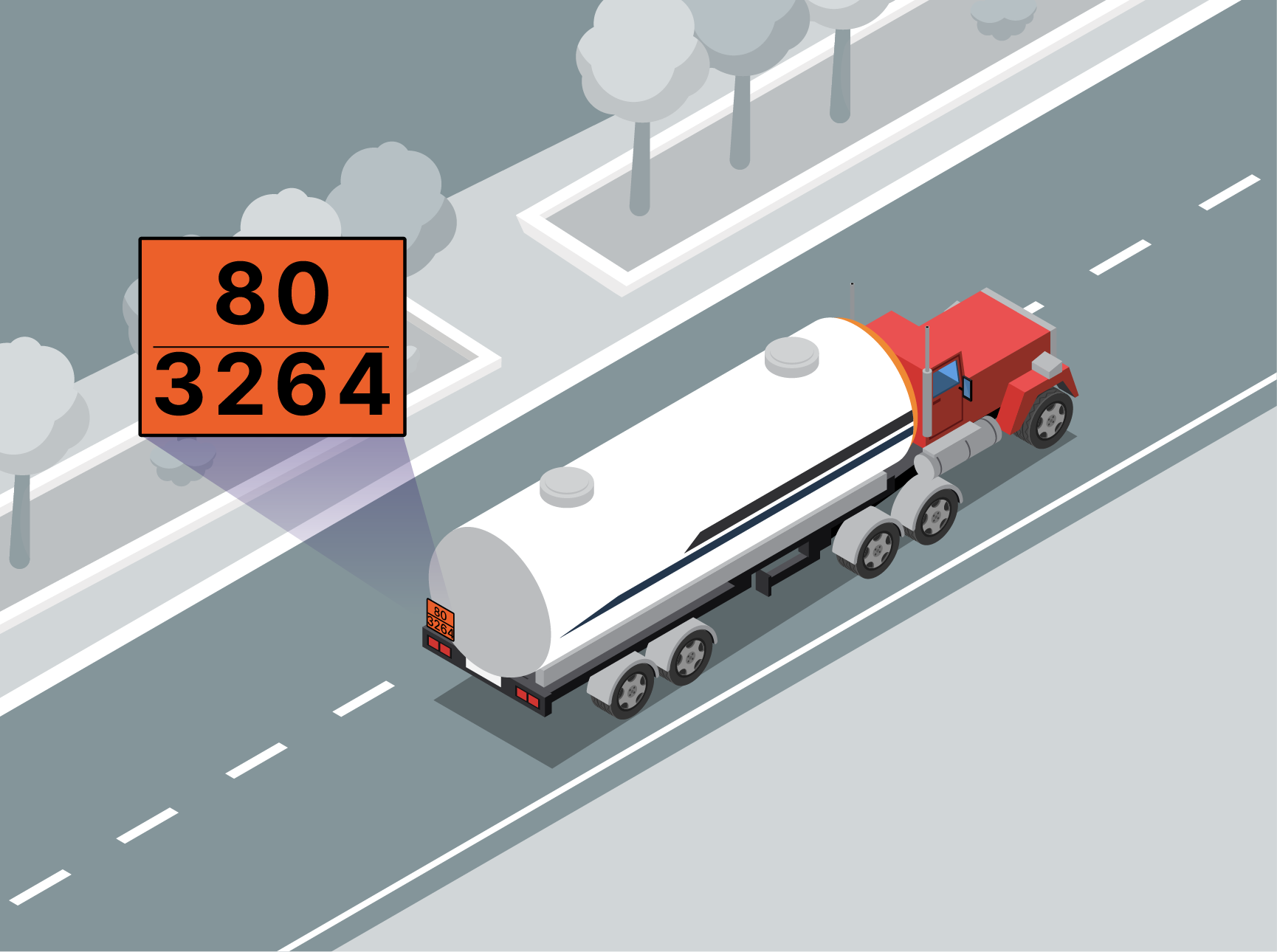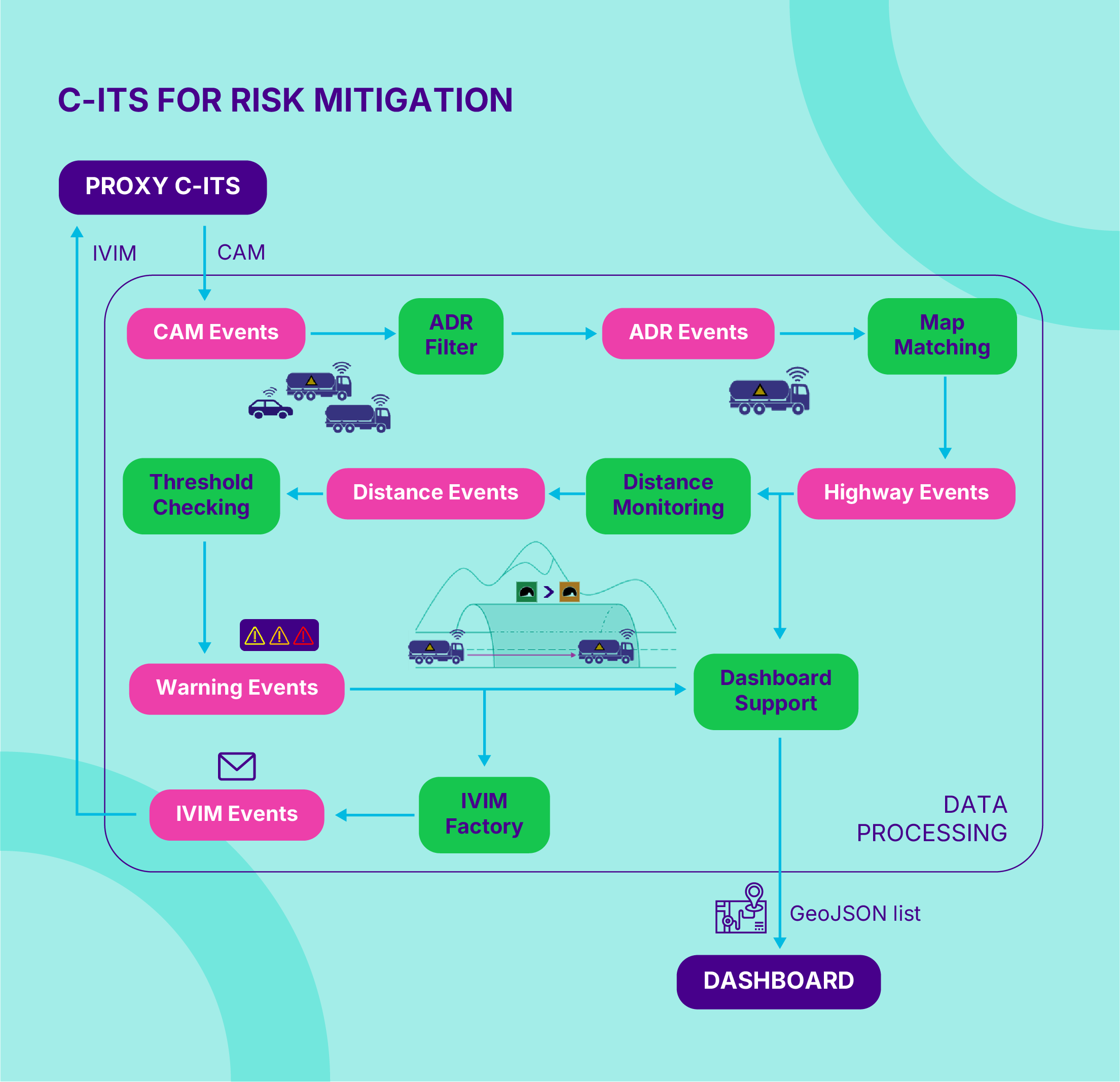
TREND > SAFE MOBILITY
Safer roads with Cooperative – Intelligent Transport Systems (C-ITS)
Innovative systems connect vehicles and infrastructure to implement active, smart control of dangerous goods transport.
Freight transportation, which is essential to the global economy, also includes movement of hazardous materials that can compromise safety, the environment and human health. Substances such as fuels and industrial solvents – flammable, toxic, and corrosive – are potentially dangerous and could exacerbate the effects of any accidents, amplifying them beyond the immediately affected area, with serious repercussions for infrastructure, the environment, and mobility. Managing accidents involving dangerous goods also entails extended response time and high costs; therefore, strict regulations and advanced technologies must be introduced to mitigate risks and ensure safety.

However, this reference text does not consider the interaction between vehicles, infrastructure, and the environment, which makes systemic risk management in sensitive areas quite complex. In Italy, the regulations are based on a framework of European laws and directives that transpose and periodically update the ADR (Accord européen relatif au transport international des marchandises Dangereuses par Route) to regulate transport, including at a national level. Of particular relevance are Directive 2008/68/EC, which regulates inland transport of dangerous goods, and ISO 39001, which promotes road safety management. With the aim of solving the problem of risk mitigation in dangerous transportation goods, new technologies can be employed to enable a continuous and effective information exchange between vehicles and road infrastructure and provide safety services.
Data analysis and issue identification
To assess the risks associated with dangerous goods transportation, Movyon conducted a preliminary analysis based on data collected by an OCR (Optical Character Recognition) monitoring system. The system detects the orange plates on dangerous containers (Figure 1) using cameras installed on highway portals located at critical points such as tunnel entrances and exits. This can be exploited to map flows and estimate risk exposure. In any case, the data analysis revealed one particularly critical aspect: in just one year, more than 2,000 vehicles carrying dangerous goods passed through the same highway tunnel within 10 seconds of each other, at a distance of less than 250 meters. In some cases, the vehicles even drove in single file, with virtually no separation.
Although these numbers may seem small compared to the overall traffic, and despite the fact that the vehicles were formally complying with the minimum distance required by the traffic regulations, the potential risk remains high. In the event of an accident, in fact, proximity between dangerous vehicles can turn a limited event into a chain disaster, with serious consequences for the safety of people, infrastructure and the environment.
In this context, it is valuable to consider a system capable of enhancing the safety levels of dangerous goods transportation—not only by monitoring vehicle transit, but also by providing road operators with greater real-time awareness of the presence and behavior of potentially high-risk vehicles. In fact, the road operator’s visibility remains limited to specific control sections, leaving large portions of the network unmonitored.
Greater safety in dangerous goods transportation
Cooperative intelligent transportation systems (C-ITS) have proven to be the most effective answer to the challenges of transporting dangerous goods. With the ability to link vehicles and road infrastructure directly, C-ITS enable a radical transformation in the approach to risk management from passive surveillance to active and intelligent control. In this context, the dynamic management of vehicle spacing takes into account various factors—such as tunnels, heavy traffic, and adverse weather conditions—and adapts accordingly. This paradigm shift enables road operators to intervene in real time, monitor critical traffic flows, and prevent potentially hazardous situations. Ultimately, C-ITS can pave the way for safer, more sustainable, and technologically advanced mobility.
A project developed in collaboration with IVECO led to the creation of a Proof of Concept, equipping vehicles with the necessary technology to communicate in real time with road infrastructure. This enables Vehicle-to-Infrastructure (V2I) communication and advanced monitoring of dangerous goods transits. Specifically, communication between vehicles and the road infrastructure is based on the Cooperative Awareness Messages (CAM) standard. Vehicles can enrich the exchanged messages by adding specific data fields—such as the Kemler code, UN number, and quantity of transported substances—entered directly by the driver prior to departure via dedicated Human Machine Interfaces (HMI) in the vehicle or through a smartphone application. These additional data allow for detailed tracking of cargo characteristics, providing the motorway operator with a complete and real-time picture.
Thanks to this information and a dedicated dashboard, it is possible to map all vehicles transporting hazardous materials. The system does not just display the data; in fact, an advanced spacing management algorithm has been designed, based on the data transmitted in the CAMs.
The system filters messages from vehicles carrying dangerous goods, applies a map-matching algorithm to accurately place them on the highway chart (e.g. to distinguish whether they are in a tunnel or open area), and monitors their travel status in real time, including whether they are using hazard lights or an abnormal speed.
If the distance between two vehicles of the same type falls below a critical threshold (which depends on the context), the system automatically generates an Infrastructure-to-Vehicle Information Message (IVIM) addressed to the vehicle behind. The IVIM message contains the real-time distance to the vehicle ahead, an alert level (warning, alert, alarm) that depends on the distance and situation, and a driving suggestion such as “keep your distance”, “slow down” or, in the most extreme cases, “stop or change route if possible”.


Benefits
With this system, the infrastructure operator can detect in real time both the presence and the type of hazardous materials moving through the network. This advanced level of visibility allows for faster and more effective emergency response, while also enabling proactive risk mitigation strategies. Among these, the dynamic management of spacing between vehicles transporting dangerous goods stands out as a concrete example of how direct vehicle-to-infrastructure communication can help prevent critical situations before they escalate into catastrophic events.
Giovanni Megna, R&D Specialist

Research & Development
We collaborate with startups, research centers and universities, in Italy and abroad, to develop solutions that improve operational processes and introduce new features, making mobility more efficient, safe and sustainable. As the technology hub of the Autostrade per l’Italia Group, we are committed to developing advanced solutions for improving mobility, with applications ranging from motorways to urban infrastructure.